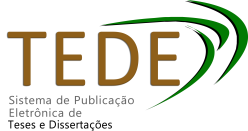| ???jsp.display-item.social.title??? |


|
Please use this identifier to cite or link to this item:
http://localhost:8080/tede/handle/tede/189| ???metadata.dc.type???: | Tese |
| Title: | COSMOLOGICAL APPLICATIONS OF FAST RADIO BURSTS |
| ???metadata.dc.creator???: | LEMOS PORCIUNCULA ALVES, THAIS |
| ???metadata.dc.contributor.advisor1???: | SOUZA DE ALCANIZ, JAILSON |
| ???metadata.dc.description.resumo???: | As \textit{fast radio bursts} (FRBs) são uma nova classe de eventos transitórios de alta energia com curta duração na faixa da frequência do rádio de algumas centenas a alguns milhares de MHz. Embora o mecanismo físico responsável por estes eventos ainda esteja em debate, o grande valor da medida de dispersão observada ($\mathrm{DM}$) acima da contribuição da Via Láctea sugere uma origem extragaláctica ou cosmológica para as FRBs. Ao identificar a origem da explosão, é possível medir diretamente o \textit{redshift} e combiná-lo com $\mathrm{DM}$ e, assim, estudar cosmologia. Por exemplo, a partir da relação $\mathrm{DM}-z$ pode-se testar o princípio da equivalência fraca ou restringir os parâmetros cosmológicos, como a fração da massa de bárions no meio intergaláctico ($f_{\mathrm{IGM}}$, onde IGM denota o meio intergaláctico, vindo do inglês {\it intergalactic medium}) e a constante de Hubble. Desde a primeira FRB descoberta em 2007 pelo telescópio Parkes, quase mil eventos foram detectados por novos telescópios. No entanto, apenas alguns FRBs na literatura estão bem localizados (com \textit{redshift} da galáxia hospedeira), e este número não é ainda grande o suficiente para realizar análises estatísticas robustas num cenário cosmológico. As outras questões nas análises das FRB são: (i) o $f_{\mathrm{IGM}}$ é fortemente degenerado com os parâmetros cosmológicos e não está bem restrito; (ii) a grande variância no $\mathrm{DM}$ devido às heterogeneidades na densidade de elétrons cósmicos não é bem modelada; (iii) e por último, o conhecimento limitado da contribuição da galáxia hospedeira. Neste contexto, na primeira parte desta Tese, discutimos em detalhes as principais características astrofísicas dos FRBs. Na segunda parte, que discute algumas aplicações de FRBs em cosmologia, apresentamos um método independente do modelo cosmológico para estimar o $f_{\mathrm{IGM}}$ e a contribuição da galáxia hospedeira, combinando FRBs com galáxias hospedeiras localizadas e de dados de supernovas tipo Ia. Usamos os dados mais atuais das FRBs observadas e, em seguida, exploramos como pesquisas futuras irão melhorar a estimativa desses parâmetros, simulando os dados de FRBs a partir do método de simulação de Monte Carlo. Além disso, testamos nossas teorias físicas buscando uma variação espaço-temporal das constantes fundamentais. Em particular, utilizamos a medida de dispersão de FRBs para investigar uma possível evolução do \textit{redshift} da constante de estrutura fina ($\alpha$), considerando o cenário do \textit{runaway dilaton}. Usando um método independente do modelo cosmológico, derivamos novas expressões para a dependência de $\mathrm{DM}$ em relação à constante de estrutura fina. |
| Abstract: | Fast radio bursts (FRBs) are a new class of high-energy transient events with short duration within the radio frequency range from a few hundred to a few thousand MHz. Although the physical mechanism responsible for these events is still in debate, the larger value of the observed dispersion measure ($\mathrm{DM}$) above that of the Milk Way contribution suggests an extragalactic or cosmological origin for the FRBs. By identifying the origin of the burst, it is possible to measure the redshift directly and can be combined with $\mathrm{DM}$ to study cosmology. For instance, from the $\mathrm{DM}-z$ relation one can test the weak equivalence principle and constrain the cosmological parameters, such as the fraction of baryon mass in the intergalactic medium ($f_{\mathrm{IGM}}$) and the Hubble constant. Since the first discovered FRB in 2007 by the Parkes telescope, almost one thousand events have been detected by new survey telescopes. However, only a few FRBs in the literature are well localized (with redshift of the host galaxy), and this number is not large enough to perform robust statistical analysis in a cosmological scenario. The other issues in FRB analyses are: (i) the $f_{\mathrm{IGM}}$ is strongly degenerated with the cosmological parameters and is not well constrained; (ii) the poor modeling of the large variance in the $\mathrm{DM}$ due to inhomogeneities in the cosmic electrons density; (iii) and lastly, the limited knowledge of the host galaxy contribution. In this context, in the first part of this Thesis, we discuss in detail the main astrophysical features of FRB. In the second part, dedicated to the cosmological application of FRBs, we present a cosmological model-independent method to estimate the $f_{\mathrm{IGM}}$ and host galaxy contribution by combining FRBs with localized host galaxy and supernovae type Ia dataset. We use the current FRBs observational data and then we explore how future surveys will improve these parameters estimation by simulating the FRBs data from Monte Carlo simulation method. In the second part, we test our physical theories by searching for a space-time variation of the fundamental constants. In particular, we use the dispersion measure of FRBs to investigate a possible redshift evolution of the fine-structure constant ($\alpha$), considering the runaway dilaton scenario. Using a cosmological model-independent method, we derive new expressions for $\mathrm{DM}$ dependence concerning the fine-structure constant. |
| Keywords: | Cosmologia;Fast Radio Bursts;Simulação de Monte Carlo;Meio Intergaláctico;Fração de Bárions |
| ???metadata.dc.subject.cnpq???: | ASTROFISICA EXTRAGALACTICA::COSMOLOGIA |
| Language: | por |
| ???metadata.dc.publisher.country???: | Brasil |
| Publisher: | Observatorio Nacional |
| ???metadata.dc.publisher.initials???: | ON |
| ???metadata.dc.publisher.department???: | Divisão de Programas de Pós-Graduação - DIPPG |
| ???metadata.dc.publisher.program???: | Programa de Pós-Graduação em Astronomia |
| Citation: | LEMOS PORCIUNCULA ALVES, THAIS. COSMOLOGICAL APPLICATIONS OF FAST RADIO BURSTS. 2024, 124 páginas da Tese do Programa de Pós-Graduação em Astronomia) - ON, Rio de Janeiro |
| ???metadata.dc.rights???: | Acesso Aberto |
| URI: | http://localhost:8080/tede/handle/tede/189 |
| Issue Date: | 25-Oct-2024 |
| Appears in Collections: | Teses de Doutorado PPGA |
Files in This Item:
| File | Description | Size | Format | |
|---|---|---|---|---|
| Thais Lemos.pdf | 2.98 MB | Adobe PDF | Download/Open Preview |
Items in DSpace are protected by copyright, with all rights reserved, unless otherwise indicated.




